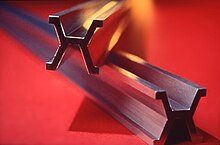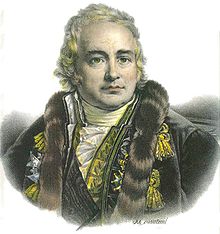Jean-Antoine Chaptal
Jean-Antoine Chaptal , Comte de Chanteloup (born June 3, 1756 in Nojaret , Badaroux , Lozère , † July 30, 1832 in Paris ) was a French chemist and politician (interior minister under Napoleon). He made a particular contribution to the chemical industry in France.
Teaching
Chaptal, son of small landowners, studied medicine in Montpellier until 1777 . In 1777 he received his doctorate in medicine and practiced as a doctor with his uncle Claude in Montpellier (a wealthy and successful doctor) before moving to Paris to study medicine and chemistry. In 1780 he was appointed to a specially established chair for chemistry at the Medical Faculty of the University of Montpellier , Languedoc, where he taught the theses of Antoine Lavoisier . In 1781 he married Anne-Marie Lajrd, daughter of a wealthy cotton merchant. In 1795 he briefly taught chemistry at the newly founded École polytechnique (with Claude Louis Berthollet , with whom he was friends).
The method of dry sugaring wine ( chaptalization ) to achieve a higher alcohol content by adding sugar to the grape juice or must before or during fermentation bears his name. In 1790 he gave the previously discovered nitrogen the element name nitrogen (= saltpeter former ), from which the element symbol N used today for nitrogen is derived.
In 1801 he was elected a foreign member of the Göttingen Academy of Sciences . From July 1807 he joined the learned society Société d'Arcueil . Since 1809 he was a foreign member of the Bavarian Academy of Sciences .
Economic activity
He put the capital that came to him through the death of a rich uncle into the construction of a chemical plant for the manufacture of mineral acids , alum , white lead , soda and other substances. His reputation is based in particular on the practical applications that he demonstrated in particular with the optimization of the production of hydrochloric acid .
His practical work has received benevolent attention from the French government. He was awarded the nobility and the ribbon of the Order of Saint Michel. During the French Revolution he was arrested for the publication of the title Dialogue entre un montagnard et un girondin . However, through the intervention of his friends, he was quickly released. In 1793 he became head of the saltpeter works of Grenelle . Between 1794 and 1797 he worked again in Montpellier and then went to Paris. In 1798 he became a member of the Académie des Sciences , of which he had been a member since 1796 as a non-Paris resident member.
Chaptal developed his winemaking tenets from 1799 onwards. He wrote the wine section of François Rozier's agricultural dictionary . Scientists like Cadet-de-Vaux and Jean-Louis Roard published his new doctrine with their specific observations. The wine industry implemented its research results immediately. Chaptal revolutionized oenology and summarized its principles in a book in 1807.
With his signature on the law of May 1, 1802, the central schools of the departments were closed and lycees were founded. The first Chamber of Commerce in present-day Germany was founded in Mainz in 1803 as Chambre de Commerce on the decision of Chaptal of the 3rd Nivôse of the year IX (December 23, 1802) .
Political activity
After the coup d'état of 18th Brumaire VIII he was appointed consul of the state by the First Consul Napoleon Bonaparte and succeeded Lucien Bonaparte as Minister of the Interior on January 21, 1801 . This was the beginning of a complete reorganization of the public administration. Chaptal's finances also recovered from the setback during the Revolution under Napoleon and in 1802 he bought a castle in Chanteloup on the Loire. He set up a chemical factory near Paris, an art school and an industrial association. He reorganized the hospitals. The creation of a midwifery school, the school l'Hospice de la Maternity de Paris, in 1802 is outstanding. The Chaptal decree regulates the redistribution of Napoleonic artistry .

He introduced the metric system for weights and measures of length and promoted the arts and sciences. Napoleon awarded him the title of Comte de Chanteloup and the Grand Cross of the Legion of Honor . Chaptal resigned in 1804 when Bonaparte was chosen to be emperor in order to devote himself to his scientific work. In the same year he became a member of the Senate.
From July 1807 he became a member of the Société d'Arcueil scientific community around the chemist Berthollet, who a. a. and Alexander von Humboldt (1769-1859) belonged.
After Napoléon's return from Elba , Chaptal became minister of labor and trade, but was forced to retreat into private life when the emperor had to abdicate. His name was removed from the list of Friends of France until 1819. Nevertheless, Chaptal was in 1816 by Louis XVIII. nominated as a member of the Academy of Sciences . Chaptal's merit was to popularize science and to apply the discoveries of chemistry practically in industry and agriculture.
Ruined by the debts of his sons who worked in the chemical industry, he sold his property in 1823 and died in poverty on July 30, 1832.
Works
- Élémens de Chymie (3 editions 1790; renewed: 1796 - 1803) (online) Chemical elements
- Traité du salpétre et des goudrons (1796) treatise on saltpeter and tars
- Tableau des principaux sels terreux (1798) Table of the main earth salts
- Essai sur le perfectionnement des arts chimiques en France (1800) (online) Attempt to perfect the chemical arts in France
- Art de faire, de gouverner, et de perfectionner les vins (first edition 1801; 2nd edition 1819) The art of making wines, controlling and improving winemaking
- Traité théorsque et pratique sur la culture de la vigne , & c. (First edition 1801; 2nd edition 1811) (online) Theoretical and practical treatise on the culture of the vine with the art of preparing wine, schnapps, brandy, vinegars - simple and compound.
- This collection contains the most modern, fundamental texts of viticulture and winemaking theory. François Rozier teaches the art of cultivating the vine, Dussieux adds notes and new observations. Chaptal provides the first treatise on wine here. It is called Essai sur le vin . There follows another treatise by Rozier on distillation and by Antoine Parmentier on vinegars.
- Essai sur le blanchiment (1801) (online) Attempts at (laundry) bleaching (1801)
- La Chimie appliquée aux arts (4 editions, 1806) (online) The chemistry applied to the arts
- Art de la peinture du coton en rouge (1807) (online) Art of dyeing red cotton
- Art du peinturier et du digraisseur (1800)
- De l'industrie française (2 editions, 1819) (online) From French industry
- Chimie appliquée à l'Agriculture (first edition 1823; 2nd edition 1829) (online) Applied agricultural chemistry. It is the last work published by Chaptal. In this newly printed treatise on classical agricultural sciences, he applies for the first time the numerous new chemical discoveries to practical, scientific and technical agriculture. Important discussions about the composition of soils, fertilizers, air temperature, the role of water, the influence of electricity on vegetation, the role of light and soil temperature.
literature
- Entry in Winfried Pötsch u. a. Lexicon of important chemists , Harri Deutsch 1989
- MP Crosland : Chaptal, Jean Antoine . In: Charles Coulston Gillispie (Ed.): Dictionary of Scientific Biography . tape 3 : Pierre Cabanis - Heinrich von Dechen . Charles Scribner's Sons, New York 1971, p. 198-203 .
- Jeff Horn and Margaret C. Jacob: Jean-Antoine Chaptal and the cultural roots of French industrialization , in: Technology and Culture 39 (1998), pp. 671-698.
Web links
- Digitized works by Chaptal - SICD of the Universities of Strasbourg
- Entry for Chaptal, Jean Antoine Claude (1756-1832) in the Archives of the Royal Society , London
Others
Chaptal is immortalized by name on the Eiffel Tower, see: The 72 names on the Eiffel Tower .
Individual evidence
- ↑ Holger Krahnke: The members of the Academy of Sciences in Göttingen 1751-2001 (= Treatises of the Academy of Sciences in Göttingen, Philological-Historical Class. Volume 3, Vol. 246 = Treatises of the Academy of Sciences in Göttingen, Mathematical-Physical Class. Episode 3, vol. 50). Vandenhoeck & Ruprecht, Göttingen 2001, ISBN 3-525-82516-1 , p. 58.
- ^ Member entry of Jean Antoine Graf von Chaptal at the Bavarian Academy of Sciences , accessed on January 14, 2017.
- ↑ No. 2008 ARRÊTÉ qui ordonne l'établissement d'un Lycée à Mayence.
- ^ Charles Coquelin, Gilbert-Urbain Guillaumin: Dictionnaire de l'économie politique contenant l'exposition des principes de la science. Guillaumin, 1864, accessed April 2, 2015 (French).
| predecessor | Office | successor |
|---|---|---|
| Lucien Bonaparte |
Minister of the Interior of France November 7, 1800 - August 7, 1804 |
Jean-Baptiste Nompère de Champagny |
| personal data | |
|---|---|
| SURNAME | Chaptal, Jean-Antoine |
| BRIEF DESCRIPTION | French chemist and politician |
| DATE OF BIRTH | June 3, 1756 |
| PLACE OF BIRTH | Nojaret, Badaroux , Lozère |
| DATE OF DEATH | July 30, 1832 |
| Place of death | Paris |
